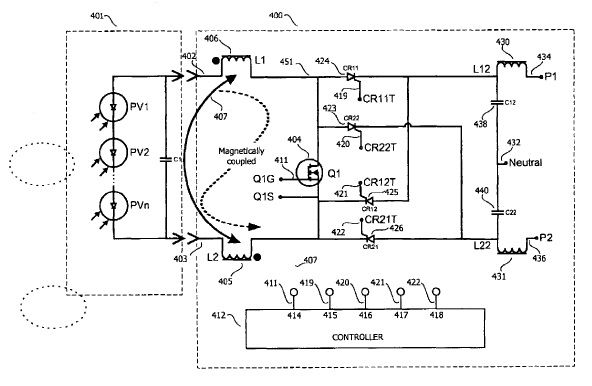(Array) is a Sunnyvale, California company that designs inverter-less solar power systems to convert the direct current (DC) electricity produced by solar modules into alternating current (AC) for the grid.
Array owns several patents relating to its converter technology, including U.S. Patent No. 7,884,500 and a patent family consisting of U.S. Patents Nos. 7,719,864, 7,929,324, and 7,929,326 (collectively, the “Converter Patents”).
The Converter Patents are directed to a DC-to-pulse amplitude modulated (PAM) current converter (which is referred to by its acronym, PAMCC) and to electrical power conversion systems comprising arrays of PAMCCs.
A PAMCC (400) receives direct current from a photovoltaic panel (401) through positive and negative input terminals (402, 403), each connected in series with coils L1 (406) and L2 (405), respectively. These coils comprise a single transformer, T1 (407).
A controller (412) controls several independent lines (419-422) of circuits (423-426). Capacitors (438, 440) are across the input side of coils (430, 432), respectively, and a neutral output terminal (432).
Control signals on lines 411 and 419-422 connect and disconnect the current provided by the PV panel (401) in sequence within the PAMCC (400) in such a way as to provide an output whose amplitude is a PAM signal approximating a sine wave.
Several claims of the Converter Patents are directed to a plurality of PAMCCs and recite the following key feature:
"The current pulses of at least two converters are out of phase with respect to each other, thereby summing the current pulses of all of the converters such that a signal modulated onto the pulse output of the converters is demodulated."
According to the Converter Patents, when an array of PAMCCs are connected in parallel such that the PAMCCs’ output pulses are out of phase with respect to each other, the result is an AC current waveform suitable for both local load use and connection to the utility grid:
"An array of PAMCCs constructed in accordance with the present invention form a distributed multiphase inverter whose combined output is the demodulated sum of the current pulse amplitude modulated by each PAMCC. If the signal modulated onto the series of discontinuous or near discontinuous pulses produced by each PAMCC was an AC current sine wave, then a demodulated, continuous AC current waveform is produced by the array of PAMCCs. This AC current waveform is suitable for use by both the “load,” meaning the premises that is powered or partially powered by the system, and suitable for connection to a grid. For example, in some embodiments, an array of a plurality of PV-plus-PAMCC modules are connected together to nominally provide split-phase, Edison system 60 cps, 240-volt AC to a home."
Other advantages discussed by the Converter Patents include that the high voltage portion of the PAMCC is physically very small (a few square inches) and can be located on the back of a solar panel assembly, making insulation simple and lightweight.
Array’s website touts the simplicity of the inverter-less technology and notes that it is “less than a quarter of the complexity of the simplest power inverter without the need of short-lived filled or plastic film components.”
The bottom line, though, is cost: "Simplicity means every cost is reduced, while Array Converter improves LCOE by both reducing each cost and increasing energy harvest," according to the firm's website.
More details on the company here. Recent news on distributed electronics for solar here.
***
Eric Lane is a patent attorney at Luce, Forward, Hamilton & Scripps in San Diego, where he works in the Intellectual Property and Climate Change & Clean Technologies practice groups. Mr. Lane can be reached at or at [email protected]. He authors the Green Patent Blog. He wll discuss his new book -- Clean Tech Intellectual Property: Eco-Marks, Green Patents and Green Innovation -- in San Francisco later this month.




